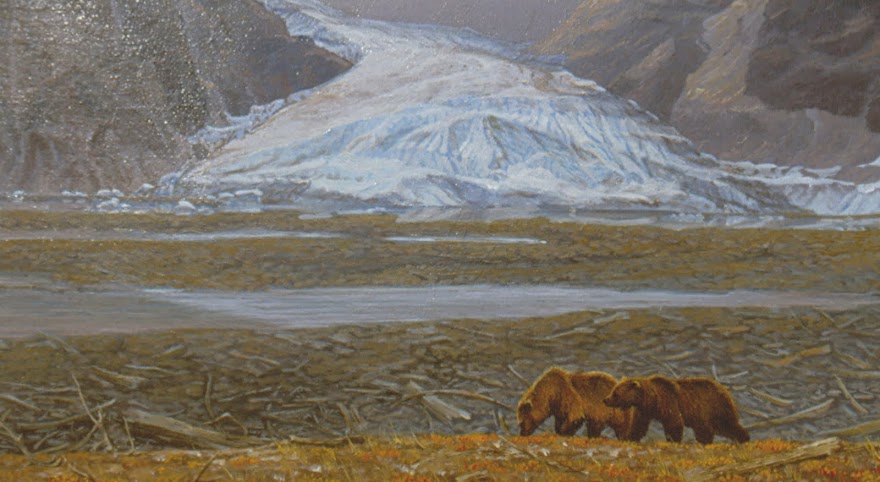The varnish is still wet on this, my latest painting. Featherweights, 10x8". The birds are Common Redpolls enduring a typical Winter's day.
This is a better photo of the last painting, Tundra Blonde, 14x11". Obviously it is the 'heavyweight' of the post title.
The rest of this post will cover a basic overview of my introduction to photography. Just a way to flesh out this post.
Recently one of my childhood friends reconnected with me. That is him with the snakes in the old photo above. By the way, he kept one of those snakes as a pet and it lived for 25 years. His name is Don, for years he thought I was dead. The other boy is Bobby and we have lost contact with him. We all lived in Carpinteria, California.
Both Donny and Bobby had Kodak instamatic cameras which they used to document our favorite activity, catching snakes. Those are Gopher snakes in the photo.
This is my current inventory of cameras, excluding the Sony Cybershot that I used to take this picture.
Anyway, back to my childhood; I wanted my own camera to take photos of the reptiles that I was obsessed with in my youth. I knew absolutely nothing about cameras and although I wanted one; it was not bad enough to lay out actual cash for one. My parents never felt that it was something that was important enough to buy for me. I could save my money and get my own if I was serious about photography.
My first camera was a 35mm, Canon TL or TX, whatever it was. I got it from a pawn shop when I was about 18. It did not even have a light meter but I did not know that there was such a thing as a light meter. When I bought my first roll of film I pulled the film out of the roll and asked my father how I was supposed to load it into the camera. He showed me how it was done and tried to explain about film speed, aperture and shutter speed. I understood none of it.
If one half of the photos of a developed roll of film came out as something recognizable I was happy. When I was twenty, someone with enough patience was able to sit me down and explain basic camera function in a way that I could grasp it.
I lost the first Canon in Mexico and my next camera was a used Pentax K1000. It had a match needle metering system. Very simple to use. I used that camera until it fell apart. Then I got a Practika which soon died. Then a Yashica which I hated, then a Konica FS-1, that broke about a day after the warranty expired.
The next camera is the one in the photo above; A Canon AE-1 Program. It still works. At the time I got it in the 1980's, I thought it was the ultimate camera. You could set the control dial on program and forget about the exposure.
Camera technology advanced and I just had to have a Canon T-70 that had a built in motor drive. It did not last long so I went back to the AE-1 program until autofocus cameras came into vogue.
I upgraded to the camera above, a Minolta XTsi. Autofocus, motor drive, auto film load, rewind, ASA etc. I was perfectly happy with it. I fully intended for this to be my final camera unless it broke, which it never did.
By the time I got this camera, digital cameras were taking over the market.
I did not care about digital cameras but film became harder and harder to find. Photography magazines only talked about digital cameras. Even Luddites like me eventually get dragged into the modern world.
I bought my first digital camera, (above) at the same time that I ought my first PC. It is a Lumix FZ-30. After about a week of learning to use it, I realized that I would never go back to film photography again. It was vastly superior to film cameras. My first one gb memory card cost 90 dollars. (How times have changed.) It broke in Ecuador. My own perspiration shorted it out.
I brought the FZ30 into a photo repair shop and learned that it would cost as much as a new camera to fix it. So I ordered a new one. By then the next generation had come out, FZ-50, (above), ten megapixels instead of 8. This is a truly great camera as far as I am concerned. I dropped it into the water in Peru but it still works.
I do not know why I felt the need to get this Fujifilm HS10 which I wrote about in the last post. It must have just been the more powerful zoom that tempted me. It is better than the Lumix.
My current favorite camera, the HS50. It may be a bit self indulgent to go over a subject like my old cameras, but I see one purpose of this blog to be a sort of (public) personal journal. I will never be likely to write any other kind of autobiography. It was fun to reminisce about old cameras.






























